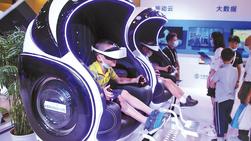 Children try out VR equipment at an industry expo in Suzhou, Jiangsu province. (WANG JIANKANG / FOR CHINA DAILY)
Children try out VR equipment at an industry expo in Suzhou, Jiangsu province. (WANG JIANKANG / FOR CHINA DAILY)
London's Victoria and Albert Museum, which describes itself as the world's largest museum of applied and decorative arts and design, is inviting visitors to take a "mind-bending" virtual reality trip to the world of Alice in Wonderland.
The museum, which is also known as the V&A, hosted a virtual reality event on Thursday to offer a sneak peek into an exhibition it will host next year called Alice: Curiouser and Curiouser.
It will be the V&A's first virtual reality event and is being held in partnership with HTC VIVE Arts.
Victoria Chang, a director at HTC VIVE Arts, said: "When the V&A and VIVE Arts first discussed the partnership in October 2019, we focused on two elements.
I think what VR offers to creators-in this case the curators of the V&A-is a very powerful tool for storytelling.
Victoria Chang, a director at HTC VIVE Arts
"First, to present a virtual reality experience as part of their Alice: Curiouser and Curiouser exhibition, allowing visitors to not only learn about the story's profound influence on art and culture through this exhibition but also to have an opportunity to be Alice-experiencing her world from a first-person perspective in a wonderland that comes to life. Second, to make this VR experience accessible to audiences around the world, via online platforms."
But as the novel coronavirus lockdown and resulting travel restrictions kicked in, the curatorial team added a third social VR element that will allow global audiences to enjoy a first look at this exhibition.
The event is accessible to people with or without a VR headset and the VR installation will be featured in the physical exhibition when it opens next year.
ALSO READ: VR Art: Fad or future?
"I think what VR offers to creators-in this case the curators of the V&A-is a very powerful tool for storytelling," Chang said.
"For example, previously you could only imagine Alice falling down the rabbit hole; this time, you actually experience zero gravity in a visceral way. You also experience physically being shrunk or enlarged. The entire experience is incredibly immersive and more emotional as a result."
During the pandemic, digital technologies have become more prevalent in the cultural sector, with many museums embracing virtual reality to give remote audiences access to art and culture, create museum tours, and make exhibits interactive.
Chang said: "At HTC VIVE Arts, our aim is to allow our partners to imagine beyond what existing tools define as possible: from the way art and culture is experienced to social engagement with the public and to partnerships with other institutions.
"Over the past months, we have witnessed an expedited adoption of digital technologies in the cultural sector, and we trust that the trend will only continue to grow."
But she added that the aim of technology is not to replace the physical experience of visiting museums, but to complement and enhance it.
"Over the last few years, and in particular following COVID-19, I think there has been a real shift in attitudes and a deeper understanding of the role technology can play in reaching new audiences, creating access to collections and exhibitions, and creating engaging content that can go hand-in-hand with more traditional displays," she said.
READ MORE: British exhibition highlights exquisite Dehua porcelain
Contact the writer at boleung@chinadailyuk.com


